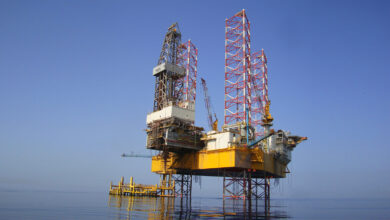Drillers, hold on for an ugly ride
 “I think we’re close to bottom” on the price of crude, Mr Adkins said, and it could end 2009 around $60/bbl. That is just a forecast, however. He notes that there’s still rampant uncertainty in the market because “we just don’t know how bad the global economy is going to get.”
“I think we’re close to bottom” on the price of crude, Mr Adkins said, and it could end 2009 around $60/bbl. That is just a forecast, however. He notes that there’s still rampant uncertainty in the market because “we just don’t know how bad the global economy is going to get.”
Still, with any stabilization in the economy in the second half of 2009, oil prices are likely to firm up, he said, then move higher in 2010 and beyond.
On the natural gas side, the picture is not as pretty. In fact, he said, it’s pretty ugly and may get uglier in 2010.
The past year has seen “unprecedented, phenomenal” growth in the US gas supply, driven primarily by technology. “It’s the application of horizontal drilling and multi-stage fracturing,” he said.
Shales have become a huge factor. For example, Barnett Shale wells were twice as productive as the average US gas well – even back in 2005. Then they got better and better. By 2007, Barnett Shale wells were three times as productive as the US average was in 2006. “This is why the US gas supply was going berserk,” he noted.
Looking at conservative numbers that have been coming out of the Haynesville, those wells are about 10 times as productive as the average gas well drilled in 2006.
What does this mean? If you take out 90% of the rigs drilling in 2006 on land and put the remaining 10% in the Haynesville, you would (theoretically, of course) get the same production growth we saw in 2006. “What that means is we may need a 60%-70% reduction in the US land rig count before you see production start to roll over,” he said.
And while supply is growing, gas demand is going down, as evidenced by recent storage data.
Even figuring in a cold winter, Mr Adkins said, it’s possible that 10 billion cu ft of gas per day will be shut in – that’s about 20% of the 50 billion cu ft produced in the US every day. In some regions, “that will take gas prices essentially to nothing. … Any way you slice it, it’s going to be pretty ugly for natural gas this summer.”
To affect a no-growth scenario for natural gas, the rig count needs to be reduced by 20% year over year, he said, and the first wells to go will be the small producers, while Haynesville wells will certainly keep on producing.
So could the rig count go down by 60-70%? Absolutely, he said. “You may be down 60% and still not see a negative gas supply.”




